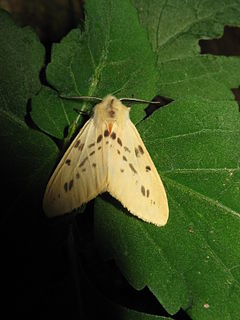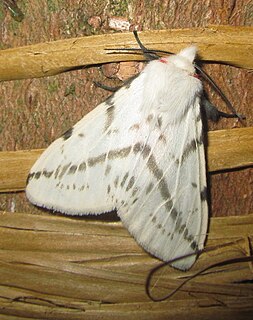
Lemyra is a genus of tiger moths in the family Erebidae. The genus contains many species from East and South Asia, Sundaland and Australia. It was described by Francis Walker in 1856.

Sarbanissa is a genus of moths of the family Noctuidae. The genus was erected by Francis Walker in 1875.
Cispia is a genus of tussock moths in the family Erebidae. It was described by Francis Walker in 1855. They are found in India, Bhutan, Sri Lanka, China and southeast Asia.

Euproctis is a genus of tussock moths in the family Erebidae described by Jacob Hübner in 1819. Species are cosmopolitan, widespread throughout Palearctic, African, Oriental and Australian regions. Molecular phylogenetic studies indicate that the genus as presently understood comprises a large number of unrelated lineages, only a few of which have names, and is therefore in serious need of revision.

Laelia is a genus of tussock moths in the family Erebidae. The genus was described by Stephens in 1828. Species are well distributed throughout Europe, Japan, China, India, Sri Lanka, Myanmar and Java.

The House of Carafa or Caraffa is a noble Neapolitan family of Italian nobles, clergy, and men of arts, known from the 12th century. The family rose to prominence during the 14th century, under the Angevin rule in Naples and established itself as one of the leading noble families of southern Italy in the 15th century under the Aragonese dynasty. Across the time, the family split in many lines, the most important being the Princes of Roccella, the Dukes of Andria, the Princes of Stigliano, the Dukes of Maddaloni, the Dukes of Nocera and the Dukes of Noja. The family gave sixteen cardinals to the Church, including one pope, Paul IV.

Lemyra punctilinea is a moth of the family Erebidae first described by Frederic Moore in 1879. It is found in Sichuan, Shaanxi, Yunnan, Pakistan, Kashmir, the Himalayas, Assam and Nepal.

Lemyra inaequalis is a moth of the family Erebidae first described by Arthur Gardiner Butler in 1879. It is found in Japan and Korea.

Cyclanoline is an acetylcholinesterase inhibitor isolated from Stephania venosa tuber.
Prabhasa venosa is a moth of the family Erebidae. It is found in eastern India, Myanmar, Thailand, China and Taiwan.
Lemyra obliquivitta is a moth of the family Erebidae. It was described by Frederic Moore in 1879. It is found in China, Nepal, Bhutan, India, Myanmar and Thailand.
Lemyra bimaculata is a moth of the family Erebidae. It was described by Frederic Moore in 1879. It is found in eastern India and Nepal.
Lemyra biseriata is a moth of the family Erebidae. It was described by Frederic Moore in 1877. It is found in India and Nepal.
Lemyra flammeola is a moth of the family Erebidae. It was described by Frederic Moore in 1877. It is found in China.
Lemyra flavalis is a moth of the family Erebidae. It was described by Frederic Moore in 1865. It is found in China, Nepal, India, Bhutan and Myanmar.

Lemyra multivittata is a moth of the family Erebidae. It was described by Frederic Moore in 1865. It is found in Nepal, India, Myanmar and China.
Lemyra rubidorsa is a moth of the family Erebidae. It was described by Frederic Moore in 1865. It is found in Pakistan (Kashmir), India and China.
Lemyra sikkimensis is a moth of the family Erebidae. It was described by Frederic Moore in 1879. It is found in India and China.

Lemyra stigmata is a moth of the family Erebidae. It was described by Frederic Moore in 1865. It is found in China, Pakistan, India, Nepal, Bhutan, Myanmar, Thailand and Vietnam.
Venosa may also refer to:









